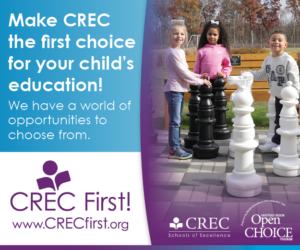On any given day at the intersection of Vernon and Washington Streets in Hartford, high school students from all over Connecticut are singing, dancing, acting, performing, playing instruments, creating art, and stagecraft. They’re also learning about something many public schools shy away from teaching: Equity, equality and the history of marginalized people.
“We have open conversations about social justice issues, whereas, at some of the schools, it’s like, ‘No, no, no, we don’t talk about that!’” said college-bound senior Cecil Pond of East Granby. “Teachers don’t want to get in trouble.”
Pond, 18, is a trans man, studying visual arts at the Greater Hartford Academy of the Arts Half Day Program, colloquially known as GHAA. It’s part of the Capitol Region Education Council and located in Hartford’s Learning Corridor. Like their classmates, Pond attends public high school in their hometown in the morning. On Monday through Thursday, they ride a bus to Hartford four afternoons a week for classes that don’t end until 4:15. Then they board another bus for the long ride home.
“It’s a busy schedule, but it is super fun here,” they said. And aside from exploring different media, Pond said what they like best is the diversity at GHAA.
Same goes for the faculty and administration, echoed Pond’s teacher, Wesley Santiago. “One of the reasons I teach here is because of the diversity. And I think I’ve learned a lot since I’ve come here to open-up my view of what diversity is,” Santiago said.
“I think it’s also an education that’s missing in a lot of schools,” he said. “We talk about how the struggles between different people, whether it’s the LGBTQIA+ community, whether it’s the African-American community, the struggles are very similar, and the struggles inspired each other.
“The environment makes you feel very welcome, be seen without needing to restate your pronouns every single day. The faculty here remembers and takes note of that, and on the attendance sheets, they’ll write a note of your chosen name and people will refer to you by that, and remember that.”
“Remember my name! Remember! Remember!” The iconic Irene Cara theme song from the 1980s television show, Fame, immediately springs to mind. Or perhaps for these young people, Glee.
“I am gay, Black and Puerto Rican,” said theater department senior Andrew Rivera of Bristol, who is also making plans for college.
“We’re reading a lot of stories that have to do with identity, racial and sexual and that kind of stuff. A lot of things that we talk about in the class relate to me,” said Rivera, 17. “Very, very much so.”
When he writes for his future audience, he chooses to avoid negativity, he said, “Because they deserve to know that being gay, being trans, being whatever, isn’t all doom and gloom. If you’re not cis and you’re not white and you’re not straight, your life is terrible! Yes, it can be, but it does not necessarily mean that is the only reason it is that way.”
Vivian Speaks, also 17, is majoring in theater design and production and described herself as mixed race: Portuguese, Black, Puerto Rican, white. Her dream is to leave New Britain for Georgia to make film and television. What GHAA has taught her reflects its motto, “Make art… Change the world.”
“Be yourself, love yourself, because that’s all you have,” she said. “Just express yourself. There’s nothing to lose! You only have one life in this world. Express it to the most that you can.”
According to Director Kim Stroud, about 400 students attend GHAA’s Half-Day Program, and another 400 are enrolled full-time. There’s no tuition; it’s free. Free transportation is also provided by CREC. But there is one thing every student has to do: audition. “I think the word ‘audition’ scares people in a way that it shouldn’t,” said theater teacher Hannah Simms, who identifies as queer. “It’s really a ‘getting to know you’ process, and no one is told they can’t come to the school based on the audition,” she said. “It’s to figure out which department is the best fit for you.”
Stroud has been with the academy almost 30 years. “Some time ago, we decided that we would be a social justice institution, and we have embraced that wholeheartedly,” she said. “We have made conscious efforts to include it in the curriculum.” She says students encounter social justice on many levels, and she adds, “We’re really excited about it. It empowers the students. It gives them opportunity to be decision makers and have voices that are heard. And I think it makes them better artists.”
—Dawn Ennis








More Stories
More Than Ever, Pride as Resistance, Visibility and Unity
Grounding in Daily Purposeful Actions
It’s (Not) All In Your Head: Mental Health And Sex